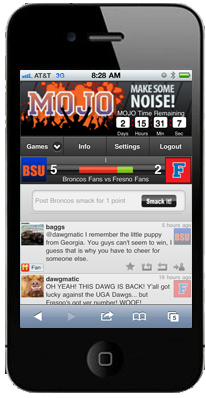For the past couple of weeks our team has focused on developing a mobile and web game app, GiveMojo (http://www.givemojo.com). GiveMojo is a fast growing mobile and web game that is specifically designed to get fans more engaged in a sporting event. Basically GiveMojo provides an engaging forum for fans to compete against fans to see who can give the most mojo to their team by flipping “smack” and earning mojo points.
Our team has really enjoyed this project. We have spent a concerted effort with the game idea creators, Karl Meinhardt and David McCauley to accomplish three primary goals:
- Create an easy to use game interface that gets fans into the game
- Eliminate friction points that make it difficult for users to join, login, play, invite others and otherwise participate
- Develop a “sticky” app that keeps users engaged
I have noted a few key items that contributed to the successful launch of Give Mojo These items are applicable to both business and game applications.
- Start with a well-designed plan for your mobile app
Take the time to create design mockups of the application. This provides a powerful , essential tool to discuss and think through application flow, game or business logic, conditional inputs, expected results and back-end-integration - Test the application in at least two phases:
Phase 1: Testing in phase 1 includea those who were directly involved in the the application idea and a select group of target users. In the case of GiveMojo this group included the game concept creators, developers, project managers and a couple target app user, i.e. serious college football fans. Our primary purpose in Phase 1 was to ensure the application functioned according to the technical specification, identify glaring performance issues and get user feedback.
Phase 2 “Polishing Phase”
In my opinion this is the critical phase of testing because it provides the final feedback you need to polish and fine-tune the application for official launch. This is typically a soft launch of the application.During phase 2 testing we include testers from our first phase and extend the group to included “non-interested” parties. In the case of GiveMojo, our “non-interested” testers included casual football fans and even a few non-football fans.Why include “non-interested” users?Non-interested testers have no pre-conceived perspective on how the application should work. Their un-biased use of the application will expose friction points that make the application awkward or difficult to use. They may even uncover “dead-ends” that leave users stranded in an eternal loop or lost application no man’s land. Exposing these areas is critical to creating an app that provides a phenomenal experience for your users.Observing and listening to this group is key to creating apps that are “sticky”. Your goal is keep the user engaged. Whether it’s a game or business app providing information and a user experience that enables the user to act is critical to endearing users to your app. - Official launch and additional testing
In a perfect world the heavens open, the angels sings and the world is at one when you officially launch your application. The reality – it’s more of a satisfying sigh of accomplishment.We’ve found that in app development, no matter how much testing and tweaking you do, there are still areas for improvement. After the official launch we encourage our customers to actively monitor the application performance and user patterns. If it’s a mobile web app or web based application monitor server and bandwidth usage to ensure server resources are sufficient to provide the best experience for your users.Launching to a larger user base will inevitably expose areas where the application can be enhanced. That’s ok, expect it! We encourage our customers to ask for feedback and look for areas to improve their applications.Remember software evolves – especially with new devices, new capabilities and most importantly new ideas from you and your users.
Incorporating a great design with careful consideration for user interface design, application flow, and full testing cycles with key individuals will better ensure your business or game application success. Strive to eliminate friction and frustration points. The better the user experience the more sticky and successful your application will be.
Now come join us for a little smack talking at Give Mojo, where fans are getting into the game.
Jody Sedrick – Zenware

